Just to bring everyone up to speed, a family RESP is a tax-deferred education savings investment account with annual government grants that has multiple beneficiaries. A beneficiary can qualify for grants of 20% or more of a contribution, subject to both annual and lifetime limits, historical contributions, age, income, and province or territory of residence.
A family RESP is generally opened by parents or grandparents, though technically can be opened by a sibling, however unlikely. In addition to children or grandchildren related by blood, a child or grandchild who is adopted qualifies as a beneficiary for a family RESP. According to Employment and Social Development Canada: “Stepchildren are related to their stepparents by virtue of being the children of their parent’s spouse or common-law partner. This is referred to as “adoption in fact.”

A beneficiary must also be under 21 if they are added to an existing, qualifying family plan.
The ability to contribute to an RESP or receive a government grant for a beneficiary depends on all contributions made to all RESPs for that beneficiary and all government grants received during that beneficiary’s lifetime. Those contributions and grants are tracked based on their social insurance number, so that if there are multiple accounts—say, parents, grandparents, etc.—a running tally is kept by the government.
That said, when it comes time to taking withdrawals from a family RESP, there is more flexibility than an individual RESP, John.
Tips for saving for your children’s education
Investment options for an RESP
Cash: You can hold cash in an RESP. You don’t have to buy an investment with it, but it is probably better to do so, in order to earn a higher interest rate.
Guaranteed investment certificates (GICs): You can buy a GIC that pays a guaranteed interest rate for a specified term—typically between six months and five years. A GIC ladder with money coming due each year to pay for education costs can be a good strategy once a child hits high school.
Exchange-traded funds (ETFs): ETFs hold a basket of stocks or bonds. There are passive and active ETFs that track various indexes and trade on stock exchanges. They are diversified and can be a one-stop option for investors.
Mutual funds: Mutual funds are a common investment option for Canadians. There are active and passive mutual funds that are managed by mutual fund managers. Fees tend to be higher than for ETFs.
Bonds: Investors can buy individual bonds from corporations and governments, although it is more common to own bonds through a mutual fund or ETF.
Stocks (also called equities or securities): This generally includes stocks on the Toronto Stock Exchange, the New York Stock Exchange, or Nasdaq exchange. There are other North American stock exchanges, though, and ways to buy foreign stocks through some brokerages. Foreign, non-North American securities are most commonly purchased by buying their American Depositary Receipts (ADRs) on a U.S. exchange.
When a qualifying withdrawal is taken from an individual RESP to help fund post-secondary costs, the account balance, at any time, is broken down into three pools of money. There’s the principal, which represents your contributions; there are grants, which represent government matching contributions; and there’s growth, which represents investment growth over and above the principal and grants.
Grants and growth are taxable to the RESP beneficiary upon withdrawal, but most students have little to no income tax to pay on the taxable portion. Every taxpayer has a basic personal amount representing income they can earn tax-free. It varies based on province or territory of residence and is impacted by other income sources they have for the year. Qualifying post-secondary tuition gives rise to a tax credit as well, which usually wipes out any potential tax implications of an RESP withdrawal for most RESP beneficiaries even if they have income from a part-time job.
sponsored
MCAN Wealth 1-year non-registered GIC
go to site
Interest rate: 5.10%
Minimum amount: $1,000
Eligible for CDIC coverage: Yes
go to site
It may be wise to try to front-end load the taxable withdrawals an RESP beneficiary takes. This is because there may be additional growth on the RESP balance before the account is exhausted. It may also make sense on the assumption that an RESP beneficiary may have lower income from other sources (summer or part-time jobs, for example) in the early years of their post-secondary education as compared to their later years.
Unused grants must be paid back to the government, with growth taxed at the subscriber’s tax rate plus a 20% penalty tax—another reason to save principal for later withdrawals. Growth can be transferred into a subscriber’s registered retirement savings plan account to the extent they have RRSP room.






GIPHY App Key not set. Please check settings